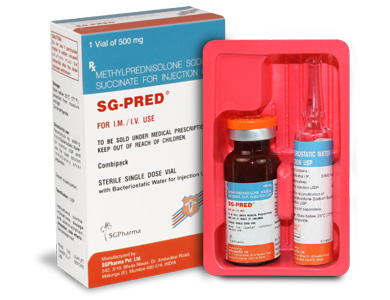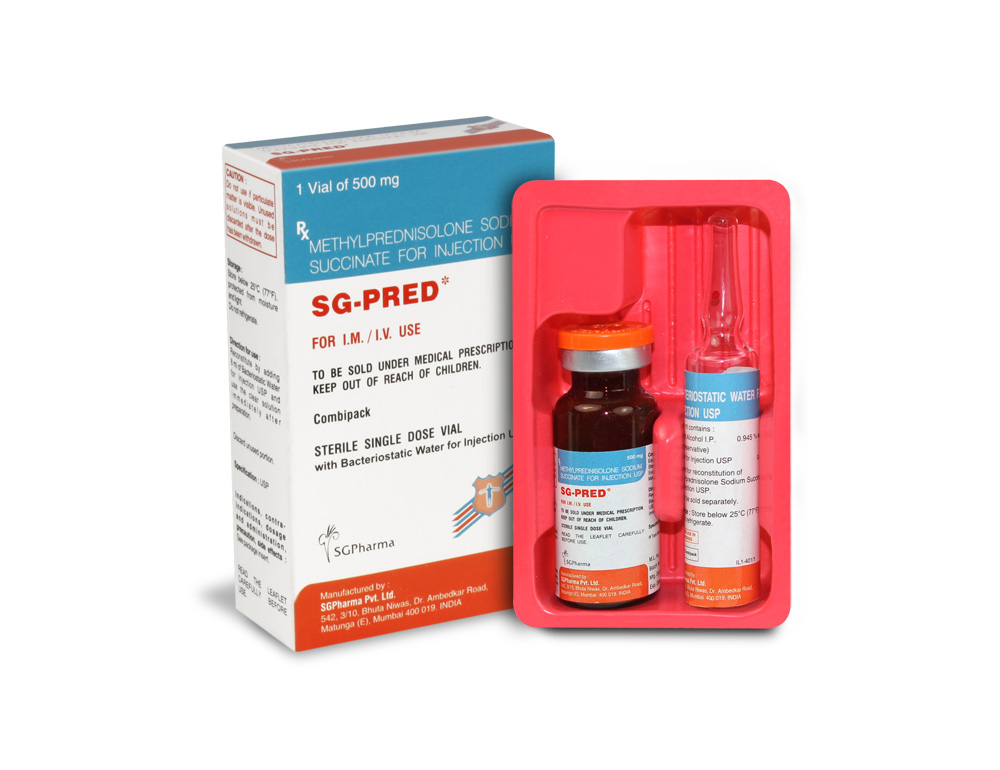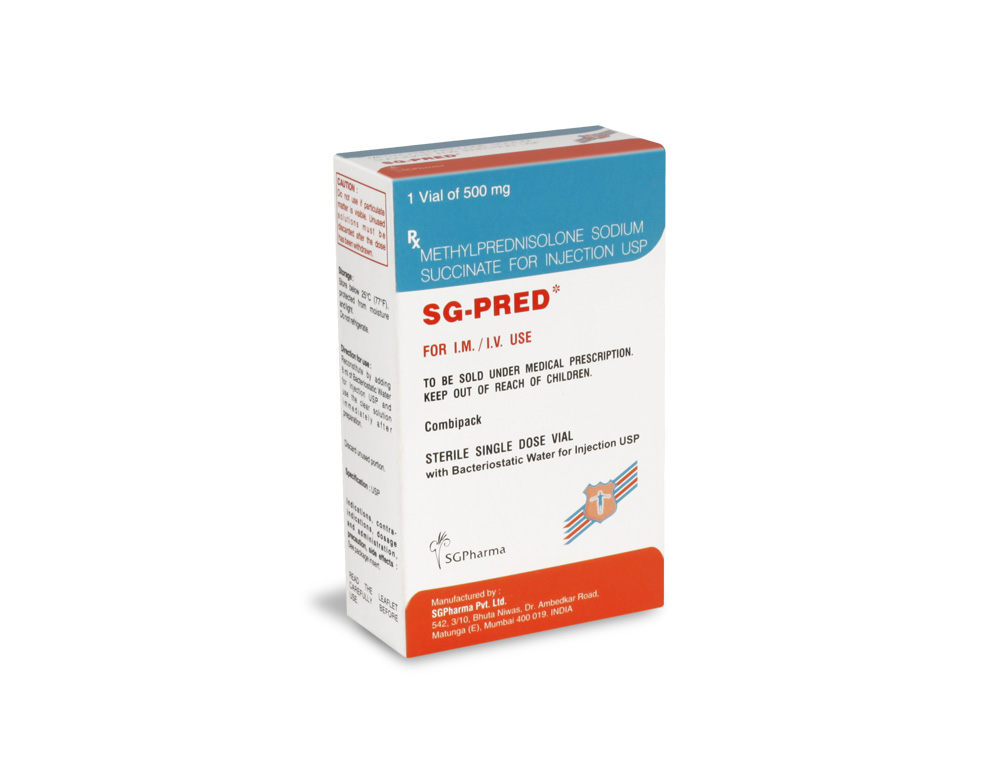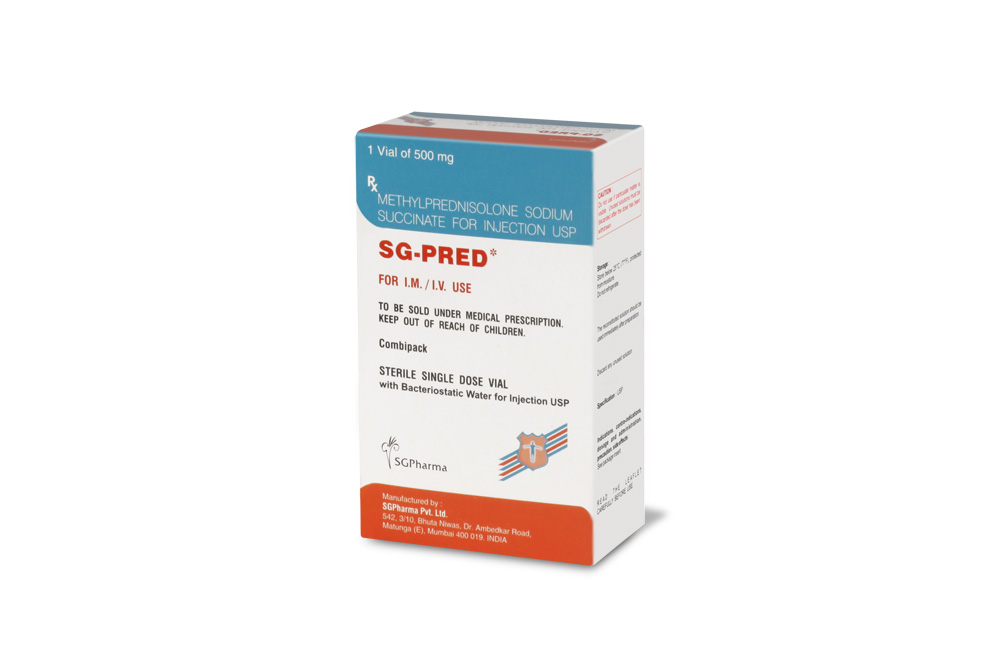
40 mg, 125 mg,
500 mg, 1gm
For the use of a Registered Medical Practitioner or a Hospital or a Institution only.
SG-PRED (Methylprednisolone Sodium Succinate) is a potent anti-inflammatory steroid. Chemically, Methylprednisolone Sodium Succinate is pregna-1,4-diene-3,20-dione,21-(3-carboxy-1-oxopropoxy)-11,17-dihydroxy-6-methyl, monosodium salt, (6α, 11β)-. The molecular formula is C26H33NaO8 and molecular weight is 496.53.
STRUCTURAL FORMULA :
Its structural formula is :
-Structure.jpg)
SG-PRED is a sterile white crystalline powder filled in vial of suitable size.
COMPOSITION :
Methylprednisolone Sodium Succinate for Injection USP 40 mg
Each vial contains :
Sterile Methylprednisolone Sodium Succinate USP
equivalent to Methylprednisolone 40 mg
(with or without Bacteriostatic Water for Injection USP 1 ml)
Methylprednisolone Sodium Succinate for Injection USP 125 mg
Each vial contains :
Sterile Methylprednisolone Sodium Succinate USP
equivalent to Methylprednisolone USP 125 mg
(with or without Bacteriostatic Water for Injection USP 2 ml)
Methylprednisolone Sodium Succinate for Injection USP 500 mg
Each vial contains :
Sterile Methylprednisolone Sodium Succinate USP
equivalent to Methylprednisolone USP 500 mg
(with or without Bacteriostatic Water for Injection USP 8 ml)
Methylprednisolone Sodium Succinate for Injection USP 1 gm
Each vial contains :
Sterile Methylprednisolone Sodium Succinate USP
equivalent to Methylprednisolone USP 1 gm
(with or without Bacteriostatic Water for Injection USP 16 ml)
ACTIONS :
Methylprednisolone is a potent anti-inflammatory steroid. It has a greater anti-inflammatory potency than prednisolone and even less tendency than prednisolone to induce sodium and water retention. Methylprednisolone sodium succinate has the same metabolic and anti-inflammatory actions as methylprednisolone. When given parenterally and in equimolar quantities, the two compounds are equivalent in biologic activity. The relative potency of SG-PRED Sterile Powder (Methylprednisolone sodium succinate) and hydrocortisone sodium succinate, as indicated by depression of eosinophil count, following intra-venous administration, is at least four to one. This is in good agreement with the relative oral potency of methylprednisolone and hydrocortisone.
PHARMACOKINETICS :
SG-PRED, the sodium succinate ester of methyl-prednisolone, is rapidly and extensively hydrolysed in vivo by cholinesterases to free methylprednisolone. The mean elimination half-life ranges from 2.4 to 3.5 hours in normal, healthy adults and appears to be independent of the route of administration. Methylprednisolone and the sodium succinate salt crosses the placental barrier. Although there is no data regarding methylprednisolone passage into breast milk of humans, it is present in breast milk of animals. Methylprednisolone is metabolised in the liver to inactive metabolites, the major ones being 20 β-hydroxymethylprednisone and 20 alpha-hydroxy-6 α-methylprednisone. Total body clearance following intravenous or intramuscular injection of methylprednisolone to healthy adult volunteers is approximately 15 - 16 l/hr. In adult volunteers receiving 40 mg SG-PRED, either I.M. or I.V., renal clearance is 0.61 - 0.83 l/hr. Methylprednisolone clearance is altered by concurrent administration of troleandomycin, erythromycin, rifampin, anti-convulsants, and theophylline. No dosing adjustments are necessary in renal failure. Methylprednisolone is haemodialisable.
INDICATIONS :
When oral therapy is not feasible, and the strength, dosage form and route of administration of the drug reasonably lend the preparation to the treatment of the condition,SG-PRED sterile powder is indicated for intravenous or intramuscular use in the following conditions :
1. Endocrine Disorders
- Primary or secondary adrenocortical insufficiency (hydrocortisone or cortisone is the drug of choice; synthetic analogs may be used in conjunction with mineralocorticoids where applicable; in infancy, mineralocorticoid supplementation is of particular importance)
- Acute adrenocortical insufficiency (hydrocortisone or cortisone is the drug of choice; mineralocorticoid supplementation may be necessary, particularly when synthetic analogs are used)
- Preoperatively and in the event of serious trauma or illness, in patients with known adrenal insufficiency or when adrenocortical reserve is doubtful
- Shock unresponsive to conventional therapy if adrenocortical insufficiency exists or is suspected
- Congenital adrenal hyperplasia
- Hypercalcaemia associated with cancer
- Nonsuppurative thyroiditis
2. Rheumatic Disorders
As adjunctive therapy for short-term administration (to tide the patient over an acute episode or exacerbation) in :
- Post-traumatic osteoarthritis
- Synovitis of osteoarthritis
- Rheumatoid arthritis, including juvenile rheumatoid arthritis (selected cases may require low-dose maintenance therapy)
- Acute and subacute bursitis
- Epicondylitis
- Acute nonspecific tenosynovitis
- Acute gouty arthritis
- Psoriatic arthritis
- Ankylosing spondylitis
3. Collagen Diseases
- During an exacerbation or as maintenance therapy in selected cases of :
- Systemic lupus erythematosus
- Systemic dermatomyositis (polymyositis)
- Acute rheumatic carditis
4. Dermatologic Diseases
- Pemphigus
- Severe erythema multi-forme (Stevens-Johnson syndrome)
- Exfoliative dermatitis
- Bullous dermatitis herpetiformis
- Severe seborrheic dermatitis
- Severe psoriasis
- Mycosis fungoides
5. Allergic States
Control of severe or incapacitating allergic conditions intractable to adequate trials of conventional treatment in :
- Bronchial asthma
- Contact dermatitis
- Atopic dermatitis
- Serum sickness
- Seasonal or perennial allergic rhinitis
- Drug hypersensitivity reactions
- Urticarial transfusion reactions
- Acute noninfectious laryngeal oedema (epinephrine is the drug of first choice)
6. Ophthalmic Diseases
Severe acute and chronic allergic and inflammatory processes involving the eye, such as :
- Herpes zoster ophthalmicus
- Iritis, iridocyclitis
- Chorioretinitis
- Diffuse posterior uveitis and choroiditis
- Optic neuritis
- Sympathetic ophthalmia
- Anterior segment inflammation
- Allergic conjunctivitis
- Allergic corneal marginal ulcers
- Keratitis
7. Gastrointestinal Diseases
To tide the patient over a critical period of the disease in :
- Ulcerative colitis (systemic therapy)
- Regional enteritis (systemic therapy)
8. Respiratory Diseases
- Symptomatic sarcoidosis
- Berylliosis
- Fulminating or disseminated pulmonary tuberculosis when used concurrently with appropriate antituberculous chemotherapy
- Loeffler’s syndrome not manageable by other means
- Aspiration pneumonitis
9. Haematologic Disorders
- Acquired (autoimmune) haemolytic anaemia
- Idiopathic thrombocytopaenic purpura in adults (I.V. only; I.M. administration is contraindicated)
- Secondary thrombocytopaenia in adults
- Erythroblastopaenia (RBC anaemia)
- Congenital (erythroid) hypoplastic anaemia
10. Neoplastic Diseases
For palliative management of :
- Leukaemias and lymphomas in adults
- Acute leukaemia of childhood
11. Oedematous States
- To induce diuresis or remission of proteinuria in the nephrotic syndrome, without uraemia, of the idiopathic type or that due to lupus erythematosus
12. Nervous System
- Acute exacerbations of multiple sclerosis
13. Miscellaneous
- Tuberculous meningitis with subarachnoid block or impending block when used concurrently with appropriate antituberculous chemotherapy
- Trichinosis with neurologic or myocardial involvement
- Organ Transplantation
- Prevention of nausea and vomiting associated with cancer chemotherapy
14. Cardiovascular Conditions
- Shock secondary to adrenocortical insufficiency or shock unresponsive to conventional therapy when adrenal cortical insufficiency may be present. (Hydrocortisone is generally the drug of choice. When mineralocorticoid activity is undesirable, methylprednisolone may be preferred.)
Administration :
SG-PRED may be administered by intravenous or intramuscular injection or by intravenous infusion, the preferred method for initial emergency use being intravenous injection. To administer by intravenous (or intramuscular) injection, prepare solution as directed. The desired dose may be administered intravenously over a period of several minutes. To prepare solutions for intravenous infusion, first prepare the solution for injection as directed. This solution may then be added to indicated amounts of 5 % dextrose in water, isotonic saline solution or 5 % dextrose in isotonic saline solution.
Directions for Reconstitution
1. Remove protective cap.
2. Cleanse stopper with suitable germicide.
3. Aseptically add 1 ml Bacteriostatic Water for Injection USP (with benzyl alcohol) for the 40 mg vial or 2 ml Bacteriostatic Water for Injection USP (with benzyl alcohol) for the 125 mg vial or 8 ml Bacteriostatic Water for Injection USP (with benzyl alcohol) for the 500 mg vial or 16 ml Bacteriostatic Water for Injection USP (with benzyl alcohol) for the 1 gm vial.
4. Agitate to effect solution.
5. Invert vial. Insert needle through target area of stopper until tip is just visible. Withdraw dose.
Dosage :
By intramuscular injection or slow intravenous injection or infusion, initially 10 – 500 mg; graft rejection, up to 1 g daily by intravenous infusion for up to 3 days.
CONTRAINDICATIONS :
The use of SG-PRED sterile powder is contraindicated in premature infants because the reconstitution diluent contains benzyl alcohol. Benzyl alcohol has been reported to be associated with a fatal “Gasping Syndrome” in premature infants. SG-PRED sterile powder is also contraindicated in systemic fungal infections and patients with known hypersensitivity to the product and its constituents.
WARNINGS :
While on corticosteroid therapy patients should not be vaccinated against smallpox. Other immunization procedures should not be undertaken in patients who are on corticosteroids, especially on high dose, because of possible hazards of neurological complications and a lack of antibody response. In patients on corticosteroid therapy subjected to unusual stress, increased dosage of rapidly acting corticosteroids before, during and after the stressful situation is indicated. Corticosteroids may mask some signs of infection, and new infections may appear during their use. There may be decreased resistance and inability to localise infection when corticosteroids are used. Infections with any pathogen including viral, bacterial, fungal, protozoan or helminthic infections, in any location in the body, may be associated with the use of corticosteroids alone or in combination with other immunosuppressive agents that affect cellular immunity, humoral immunity, or neutrophil function. These infections may be mild, but can be severe and at times fatal. With increasing doses of corticosteroids, the rate of occurrence of infectious complications increases.
The use of SG-PRED Sterile Powder (methylprednisolone sodium succinate) in active tuberculosis should be restricted to those cases of fulminating or disseminated tuberculosis in which the corticosteroid is used for the management of the disease in conjunction with appropriate anti-tuberculosis regimen. If corticosteroids are indicated in patients with latent tuberculosis or tuberculin reactivity, close observation is necessary as reactivation of the disease may occur. During prolonged corticosteroid therapy, these patients should receive chemoprophylaxis. Because rare instances of anaphylactoid (eg, bronchospasm) reactions have occurred in patients receiving parenteral corticosteroid therapy, appropriate precautionary measures should be taken prior to administration, especially when the patient has a history of allergy to any drug.
There are reports of cardiac arrhythmias and/or circulatory collapse and/or cardiac arrest following the rapid administration of large I.V. doses of methylprednisolone sodium succinate (greater than 0.5 gram administered over a period of less than 10 minutes). Bradycardia has been reported during or after the administration of large doses of methylprednisolone sodium succinate, and may be unrelated to the speed or duration of infusion. This product contains benzyl alcohol. Benzyl alcohol has been reported to be associated with a fatal “Gasping Syndrome” in premature infants. Prolonged use of corticosteroids may produce posterior subcapsular cataracts, glaucoma with possible damage to the optic nerves, and may enhance the establishment of secondary ocular infections due to fungi or viruses.
Average and large doses of cortisone or hydrocortisone can cause elevation of blood pressure, salt and water retention, and increased excretion of potassium. These effects are less likely to occur with the synthetic derivatives except when used in large doses. Dietary salt restriction and potassium supplementation may be necessary. All corticosteroids increase calcium excretion. Persons who are on drugs which suppress the immune system are more susceptible to infections than healthy individuals. Chicken pox and measles, for example, can have a more serious or even fatal course in non-immune children or adults on corticosteroids. In such children or adults who have not had these diseases, particular care should be taken to avoid exposure. How the dose, route and duration of corticosteroid administration affects the risk of developing a disseminated infection is not known. The contribution of the underlying disease and/or prior corticosteroid treatment to the risk is also not known. If exposed to chicken pox, prophylaxis with varicella zoster immune globulin (VZIG) may be indicated. If exposed to measles, prophylaxis with pooled intramuscular immunoglobulin (IG) may be indicated.
PRECAUTIONS :
1. General Precautions
a. Corticosteroids should be used cautiously in patients with ocular herpes simplex because of possible corneal perforation.
b. Psychic derangements may appear when corticosteroids are used, ranging from euphoria, insomnia, mood swings, personality changes, and severe depression to frank psychotic manifestations. Also, existing emotional instability or psychotic tendencies may be aggravated by corticosteroids.
c. Corticosteroids should be used with caution in non-specific ulcerative colitis, if there is a probability of impending perforation, abscess or other pyogenic infection, also in diverticulitis, fresh intestinal anastomoses, active or latent peptic ulcer, renal insufficiency, hypertension, osteoporosis, or myasthenia gravis.
d. Since complications of treatment with glucocorticoids are dependent on the size of the dose and the duration of treatment, a risk/benefit decision must be made in each individual case as to dose and duration of treatment and as to whether daily or intermittent therapy should be used.
e. Convulsions have been reported with concurrent use of methylprednisolone and cyclosporin. Since concurrent administration of these agents results in a mutual inhibition of metabolism, it is possible that convulsions and other adverse events associated with the individual use of either drug may be more apt to occur.
f. An acute myopathy has been described with the use of high doses of corticosteroids, most often occurring in patients with disorders of neuromuscular transmission (eg, myasthenia gravis), or in patients receiving concomitant therapy with neuromuscular blocking drugs (eg, pancuronium). This acute myopathy is generalised, may involve ocular and respiratory muscles, and may result in quadriparesis. Elevations of creatine kinase may occur. Clinical improvement or recovery after stopping corticosteroids may require weeks to years.
g. Kaposi’s sarcoma has been reported to occur in patients receiving corticosteroid therapy. Discontinuation of corticosteroids may result in clinical remission.
2. Drug-induced secondary adrenocortical insufficiency may be minimized by gradual reduction of dosage. This type of relative insufficiency may persist for months after discontinuation of therapy; therefore, in any situation of stress occurring during that period, hormone therapy should be reinstituted. Since mineralocorticoid secretion may be impaired, salt and/or a mineralocorticoid should be administered concurrently.
3. There is an enhanced effect of corticosteroids on patients with hypothyroidism and in those with cirrhosis.
4. The lowest possible dose of corticosteroid should be used to control the condition under treatment, and when reduction in dosage is possible, the reduction should be gradual.
5. Aspirin should be used cautiously in conjunction with corticosteroids in hypoprothrombinaemia.
6. Growth and development of infants and children on prolonged corticosteroid therapy should be carefully observed.
7. Although controlled clinical trials have shown corticosteroids to be effective in speeding the resolution of acute exacerbations of multiple sclerosis, they do not show that corticosteroids affect the ultimate outcome or natural history of the disease.
Usage in pregnancy and lactation : Since adequate human reproduction studies have not been done with corticosteroids, the use of these drugs in pregnancy, nursing mothers, or women of childbearing potential requires that the possible benefits of the drug be weighed against the potential hazards to the mother and embryo or foetus. Infants born of mothers who have received substantial doses of corticosteroids during pregnancy should be carefully observed for signs of hypoadrenalism.
INTERACTIONS :
Methylprednisolone has a wide spectrum of clinical use and is therefore used with numerous concurrent drugs. The interactions summarised in the table are of known or likely clinical significance. The need for dosage adjustment of either medication will depend on the clinical situation, the dose regimen prescribed and the observed clinical response. The interactions listed have either pharmacokinetic or pharmacodynamic basis.
SIDE EFFECTS :
Fluid and Electrolyte Disturbances
- Sodium retention
- Fluid retention
- Congestive heart failure in susceptible patients
- Potassium loss
- Hypokalaemic alkalosis
- Hypertension
Musculoskeletal
- Muscle weakness
- Steroid myopathy
- Loss of muscle mass
- Severe arthralgia
- Vertebral compression fractures
- Aseptic necrosis of femoral and humeral heads
- Pathologic fracture of long bones
- Osteoporosis
Gastrointestinal
- Peptic ulcer with possible perforation and haemorrhage
- Pancreatitis
- Abdominal distention
- Ulcerative oesophagitis
Dermatologic
- Impaired wound healing
- Thin fragile skin
- Petechiae and ecchymoses
- Facial erythema
- Increased sweating
- May suppress reactions to skin tests
Neurological
- Increased intracranial pressure with papilloedema (pseudo-tumor cerebri) usually after treatment
- Convulsions
- Vertigo
- Headache
Endocrine
- Development of Cushingoid state
- Suppression of growth in children
- Secondary adrenocortical and pituitary unresponsiveness, particularly in times of stress, as in trauma, surgery or illness
- Menstrual irregularities
- Decreased carbohydrate tolerance
- Manifestations of latent diabetes mellitus
- Increased requirements for insulin or oral hypoglycemic agents in diabetics
Ophthalmic
- Posterior subcapsular cataracts
- Increased intraocular pressure
- Glaucoma
- Exophthalmos
Metabolic
- Masking of infections
- Latent infections becoming active
- Opportunistic infections
- Hypersensitivity reactions including anaphylaxis may suppress reactions to skin tests
The following additional adverse reactions are related to parenteral corticosteroid therapy :
- Hyperpigmentation or hypopigmentation
- Subcutaneous and cutaneous atrophy
- Sterile abscess
- Anaphylactic reaction with or without circulatory collapse, cardiac arrest, bronchospasm
- Urticaria
- Nausea and vomiting
- Cardiac arrhythmias; hypotension or hypertension
INFORMATION FOR PATIENTS :
Persons who are on immunosuppressant doses of corticosteroids should be warned to avoid exposure to chicken pox or measles. Patients should also be advised that if they are exposed, medical advice should be sought without delay.
OVERDOSAGE :
There is no clinical syndrome of acute overdosage with SG-PRED. Methylprednisolone is dialyzable.
PHARMACEUTICAL PRECAUTIONS :
Parenteral drug products should be inspected visually for particulate matter and discoloration prior to administration, whenever solution and container permit.
STORAGE :
Store below 250C (770F), protected from moisture and light.
Do not refrigerate.
Use the solution immediately after reconstitution.
SHELF LIFE :
24 months from the date of manufacture.
PRESENTATION :
SG-PRED (Methylprednisolone Sodium Succinate for Injection USP) is supplied as :
-Table.jpg)
Disclaimer : For the use of a Registered Medical Practitioner or a Hospital or a Institution only. Also it is not intended to be used by healthcare professionals or patients for the purpose of prescribing or administering these products. Questions regarding the complete and current content of product labeling / specification / presentation should be directed to SGPharma.

 Cardiovascular
Cardiovascular








